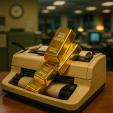Will Fear of Heights Kill the Bull?
Where to now?
Better ask your Ouija board, since no one can predict with any certainty whether Dow 10000 will be the bull market's last hurrah or merely a fuel stop on the way to the moon.
Not that the pundits and gurus lack the confidence to try. They were out in force last week, blowing enough smoke to inflate a fleet of blimps just after the blue chip average of 30 stocks breached 10000 on Tuesday for the first time ever.
By week's end, the hands-down winner in the can-you-top-this category was a prediction of Dow 125,000 -- based, it would seem, on one technical analyst's surrealistically bullish runes.
His bearish counterpart would be Gary North, a self-styled economist from Arkansas who has previously stated that the Dow Jones Industrial Average will have ceased to exist once the Year 2000 computer bug has spent its destructive force.
Otherwise, there is a vast multitude of prognosticators in the middle whose forecasts for the next few years fall mostly in the range 12000-15000.
Some of them may have gotten a psychological lift around mid-week, when two wonks from the American Enterprise Institute weighed in with an aggressively ebullient prediction of 36000-40000 on the op-ed page of The Wall Street Journal.
What these bullish forecasts have in common is the expectation that interest rates and inflation will remain low, earnings will continue to rise, and peace will endure, more or less, in all of the global hot spots.
There's plenty of room for skepticism on all counts, to say the least, and that is why I am no less bearish than I was a year ago, when the Dow was trading about 7% below current levels, at 9300.
Still, I will go on record with a forecast of Dow 15000 within two years if Asia's economies actually do turn around soon. I will further predict that if, by mid-summer, the consensus holds that Asia's economic recovery is more or less assured and that Japan Inc. has emerged from bankruptcy, the Dow will by then already be past the 12,000 mark.
Regardless of whether the bulls or bears are right, there's a lot riding on the performance of the U.S. stock market.
Its powerful surge over the last several years has helped stoke levels of consumption that have kept the economy going strong, even as U.S. households registered a negative savings rate for the first time since the Great Depression.
Our shopping binge has also boosted the exports of many countries, including Canada, Mexico and South Korea, that might otherwise have slipped into the same seemingly inescapable rut as Japan.
Will the stock market's recent milestone affect the habits of America's world-conquering shoppers or change the global status quo?
I doubt it. Americans may be a little richer on paper than they were at the end of 1998, when their share holdings were worth an estimated $10.8 trillion, but the 10% or so of capital gains they've added at the margin is probably not enough to kick consumption that's already in overdrive into hyperdrive.
The real significance of Dow 10000 comes down to whether we soon conquer it with yet another powerful surge, or succumb to it by languishing for too long at or below it.
Either outcome is possible, of course, but a consensus will likely grow around one scenario or the other over the next six to twelve months, if not sooner. As in politics, the consensus will thicken according to which way those in the middle vote their investment dollars.
History is not encouraging. In the two times the Dow has tacked on another zero, it has suffered nervous breakdowns that on average lasted nearly 18 years.
The Industrial Average first breached the century mark on January 12, 1906, with a 100.25 close. But it was not until 1924, almost 19 years later, that it broke significantly above 100, on its way to a pre-1929 Crash high just under 400.
Similarly, it took 16 years for Dow to blast free of 1000 after first touching it in 1966.
In both cases, the intervening years were marked by wild gyrations that brought the index to within an inch of old highs, only to be pounded down by vicious and numerous bear-market declines of 40% or more.
At least one top technical analyst, Peter Eliades, editor of the widely quoted Stockmarket Cycles newsletter (www.stockmarketcycles.com), thinks five-digit phobia will kill the current bull market and that it will be at least another 15-20 years before the Dow closes above 11,000.
The Santa Rosa resident says that although his prediction may smack of mysticism or numerology for some, the facts speak for themselves. "The history of what happened coupled with the fundamental data and the cyclical and technical data strongly suggest the 10,000 level will not be just another reason for a CNBC special," he says. "For many of us, it could take the better part of our lifetime, if not longer, to be significantly surpassed."
Eliades says that because the evidence is so strong, he would sooner stick is neck out and risk being embarrassed rather than sit timidly on the sidelines. "Could I be proved wrong in the blink of an eye?" he asks rhetorically. "You betcha! Otherwise, it would not be a projection worth making."

















